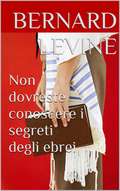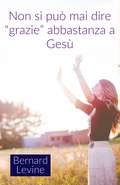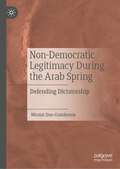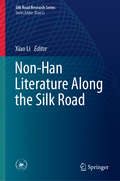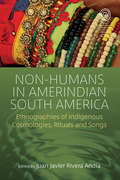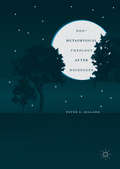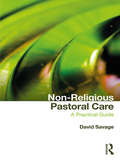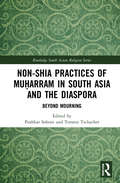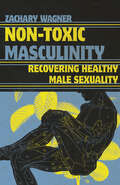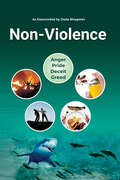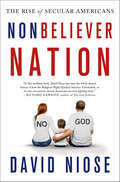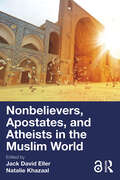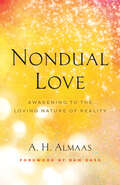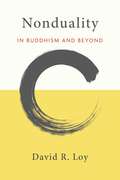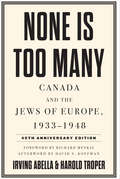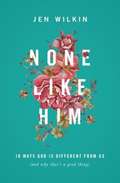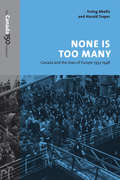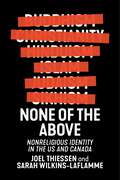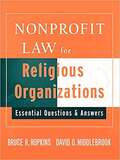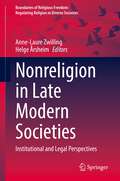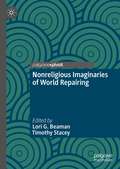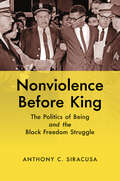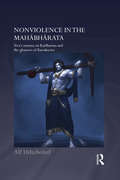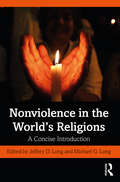- Table View
- List View
Non dovreste conoscere i segreti degli ebrei
by Stefano Vazzola Bernard LevineSapevate che agli ebrei non è concesso strappare la carta igienica durante lo Sabbath? Cosa c'è di così diverso nei rapporti sessuali degli ebrei? Perché le donne ebree non possono lettere la Bibbia? È vero che non esistono parolacce in ebraico? Sapevate che c'è una Coca-Cola fatta specificamente per gli ebrei? Qual è il cognome di Gesù? Quale lettera dell'alfabeto è stampata alla rovescia nella Bibbia? Questo è il libro di cui la gente parla e che non vuole che voi leggiate.
Non si può mai dire “grazie” abbastanza a Gesù
by Bernard LevineVi aspettavate che un Re sanguinasse e morisse per voi? Non si può mai dire “grazie” abbastanza a Gesù Vi aspettavate che un Re sanguinasse e morisse per voi? E non un Re qualsiasi! ... Ma il Re di tutti i Re, Gesù Cristo. La Bibbia è l'unico libro dove l'Autore è presente ogni volta che lo leggiamo!
Non-Democratic Legitimacy During the Arab Spring: Defending Dictatorship
by Nicolai Due-GundersenThis book analyzes non-democratic legitimacy during the Arab Spring. During this historic event, monarchs and presidents were forced to defend their rule, whether through Islam, the cultural image of paternalism or the cash flow of welfare. Can Arab leaders still justify apolitical reigns? Are monarchies more respected than republicans or are they too under threat? The author traces the history of apolitical rule in the Arab world, from Islamic roots to the role of Arab leaders in merging religion with socio-economic benefits and cosmetic liberalization. Finally, analysis of speeches given by leaders of Tunisia, Egypt, Jordan and Bahrain in response to the Arab Spring are considered. When protesters took to the streets with their slogans, the regimes talked back. This work discusses the weight of their words and why some leaders survived unrest while others were overthrown.
Non-Han Literature Along the Silk Road (Silk Road Research Series)
by Xiao LiThis volume includes outstanding scientific articles on documents written in ancient languages such as Tocharian, Sogdian, Khotanese, and Old Uyghur. Its chief aims are to contribute to the present state of research by adding essential findings on newly discovered historical documents; to present a multi-dimensional investigation of diverse aspects including the history, religion, art, literature, and social life along the Silk Road; and to outline potential future research directions for non-Han literature studies and inspire research into other aspects, such as economics and comparative studies.
Non-Humans in Amerindian South America: Ethnographies of Indigenous Cosmologies, Rituals and Songs (EASA Series #37)
by Juan Javier Rivera AndíaDrawing on fieldwork from diverse Amerindian societies whose lives and worlds are undergoing processes of transformation, adaptation, and deterioration, this volume offers new insights into the indigenous constitutions of humanity, personhood, and environment characteristic of the South American highlands and lowlands. <P><P>The resulting ethnographies – depicting non-human entities emerging in ritual, oral tradition, cosmology, shamanism and music – explore the conditions and effects of unequally ranked life forms, increased extraction of resources, continuous migration to urban centers, and the (usually) forced incorporation of current expressions of modernity into indigenous societies.
Non-Metaphysical Theology After Heidegger
by Peter S. DillardUsing Martin Heidegger's later philosophy as his springboard, Peter S. Dillard provides a radical reorientation of contemporary Christian theology. From Heidegger's initially obscure texts concerning the holy, the gods, and the last god, Dillard extracts two possible non-metaphysical theologies: a theology of Streit and a theology of Gelassenheit. Both theologies promise to avoid metaphysical antinomies that traditionally hinder theology. After describing the strengths and weaknesses of each non-metaphysical theology, Dillard develops a Gelassenheit theology that ascribes a definite phenomenology to the human encounter with divinity. This Gelassenheit theology also explains how this divinity can guide human action in concrete situations, remain deeply consonant with Christian beliefs in the Incarnation and the Trinity, and shed light on the Eucharist and Religious Vocations. Seminal ideas from Rudolf Otto and Ludwig Wittgenstein are applied at key points. Dillard concludes by encouraging others to develop an opposing Streit theology within the non-metaphysical, Heidegerrian framework he presents.
Non-Religious Pastoral Care: A Practical Guide
by David SavageThis ground-breaking book is a guide to non-religious pastoral care practice in healthcare, prisons, education, and the armed forces in the UK. It brings a new perspective to our understanding of care services traditionally offered by chaplaincy departments. The book charts the progress from a Christian to a multi-faith and on to a fully inclusive care service. Compelling evidence is presented showing strong and broad support for non-religious pastoral care provision. A practical guide, it outlines the beliefs and values on which this care is founded and its person-centred approach. The role, skills, competencies, and training requirements for non-religious pastoral carers are described. Institutions need to consider their policy responses to the rapid development of non-religious pastoral care provision. A number of policy aspects are explored, including understanding service users’ needs, recruitment, and communications. This book is essential reading for non-religious pastoral carers and those thinking of entering this field. Chaplains and institutional managers responsible for chaplaincy or spiritual care departments will find this book gives them valuable insights into the positive contribution non-religious pastoral carers can make in building stronger, more inclusive pastoral, spiritual, and religious care services.
Non-Shia Practices of Muḥarram in South Asia and the Diaspora: Beyond Mourning (Routledge South Asian Religion Series)
by Pushkar Sohoni and Torsten TschacherThis book analyses engagements with non-Shia practices of Muḥarram celebrations in the past and present, in South Asia and within a larger diaspora. Breaking new ground by bringing together a variety of regional perspectives (the Deccan, the Punjab, Singapore, South Africa, and Trinidad and Tobago) and linguistic backgrounds (Bhojpuri, Gujarati, Marathi, Punjabi, Tamil, Urdu), the chapters discuss the importance of Muḥarram celebrations in terms of their respective actors. While in some cases these include an interrelationship with Shia Muslims and their traditions of mourning during Muḥarram, other contributions address contexts in which Shias, and even Muslims, form only a minor component of the celebrations, or even none at all. Focusing on Muḥarram celebrations that are beyond the script provided by Shia Muḥarram practices, this book opens up new perspectives on Muḥarram as a social practice widely shared by South Asians across regions. The book will be a key resource to scholars and students of South Asian studies, Asian religion, in particular rituals and religious practices, and Islamic studies but also engaging to non-academic readers interested in the practices of several regions.
Non-Toxic Masculinity: Recovering Healthy Male Sexuality
by Zachary WagnerDismissals such as "boys will be boys" and "not all men" are ingrained in our world. And the purity culture of our youth sold the same excuses with a spiritual spin. Can we break the toxic cycle and recover a healthy identity for men? In Non-Toxic Masculinity, Zachary Wagner tells men, "If you are in Christ, this is your problem—and you should be part of the solution." Reflecting on his own coming of age in the purity culture movement and ongoing recovery from sexual shame, Wagner confronts harmful teaching from the American church that has distorted desire, sex, relationships, and responsibility. For those—both men and women—who feel disillusioned and adrift, this book offers a renewed vision for Christian male sexuality founded in empathy and selflessness.
Non-Violence
by Dada BhagwanThose seeking to lead a spiritual life may become curious as to what is ahimsa (non violence), and inspired to practice it. But understanding how to live in non violence is not as simple as it seems, and practicing no violence in daily life can quickly become bewildering. To someone just beginning to cultivate non-violence, daily interactions might even begin to feel like the very definition of conflict! In the book “Non-Violence”, Gnani Purush (embodiment of Self knowledge) Dada Bhagwan offers key understanding on how to define ahimsa (non violence) and how to avoid kashaya (internal self harm). Dadashri explains that kashaya is at the root of self harming, unhealthy relationships, and violence. Here, he teaches how to live in peace, offering profound knowledge of non violent communication, conflict resolution skills, and conflict management strategies.
Nonbeliever Nation: The Rise of Secular Americans
by David NioseA new group of Americans is challenging the reign of the Religious RightToday, nearly one in five Americans are nonbelievers - a rapidly growing group at a time when traditional Christian churches are dwindling in numbers - and they are flexing their muscles like never before. Yet we still see almost none of them openly serving in elected office, while Mitt Romney, Rick Santorum, and many others continue to loudly proclaim the myth of America as a Christian nation. In Nonbeliever Nation, leading secular advocate David Niose explores what this new force in politics means for the unchallenged dominance of the Religious Right. Hitting on all the hot-button issues that divide the country – from gay marriage to education policy to contentious church-state battles – he shows how this movement is gaining traction, and fighting for its rights. Now, Secular Americans—a group comprised not just of atheists and agnostics, but lapsed Catholics, secular Jews, and millions of others who have walked away from religion—are mobilizing and forming groups all over the country (even atheist clubs in Bible-belt high schools) to challenge the exaltation of religion in American politics and public life.This is a timely and important look at how growing numbers of nonbelievers, disenchanted at how far America has wandered from its secular roots, are emerging to fight for equality and rational public policy.
Nonbelievers, Apostates, and Atheists in the Muslim World
by Jack David Eller Natalie KhazaalNonbelievers, Apostates, and Atheists in the Muslim World offers a contemporary, cross-cultural look at nonbelief and nonreligion in Islam. Providing historical, conceptual, statistical, and ethnographic data on nonbelievers from Morocco to Egypt, Turkey, and Bangladesh, it explores the unique nature and challenges of nonreligion for Muslims.It includes 11 chapters by experts on nonbelief, nonreligion, and atheism in an array of Muslim-majority countries. The book features multiple disciplines and offers both ethnographic and statistical information on this important, growing, but neglected population. It explores the unique nature of nonreligion in Islam, illustrating that nonbelief is specific to a particular religious tradition. It also examines how ex-Muslims navigate complexities and dangers of their societies—especially for women—and how nonbelief and nonreligion do not equate to atheism or the total repudiation of religion or of Muslim identity.This book is an outstanding resource for scholars and students of nonbelief, atheism, secularism, religion, and contemporary Islam.Chapters 4 and 5 of this book are freely available as a downloadable Open Access PDF at http://www.taylorfrancis.com under a Creative Commons Attribution-Non Commercial-No Derivatives (CC-BY-NC-ND) 4.0 license
Nondual Love: Awakening to the Loving Nature of Reality
by A. H. AlmaasFrom beloved author and teacher A. H. Almaas, an exploration of love beyond the boundaries of the individual self, revealing that nondual love is the nature of everything, including ourselves.Love is a transformative aspect of the spiritual path—and, in fact, it is our very nature. A. H. Almaas takes us on a journey beyond a narrow, individual understanding of love to an exploration of what he calls the boundless dimension of Divine Love. This is not the kind of love that we feel toward somebody else; it is nondual, a love without boundaries. Or put another way, it is universal true nature experienced as love.By shifting our focus beyond our individual human experience to the experience of the whole of existence, we are able to see the true richness of the universe. All of reality takes on a quality of inner light, of softness and ease, of sweetness and holding. When we are open to the dimension of nondual love, we can relax and trust our inner ground that is also the ground of everything: our true nature, free from limitations—a sense of complete release, freedom, and delight, that is free of conflict, fear, insecurity, and worry. Almaas discusses the obstacles that make it difficult to awaken to true nature in this form, such as our belief in a separate self and our past conditioning. Each chapter includes an inquiry or practice, such as explorations of attachments and worldly desires as well as inquiries into union, surrender, and grace.
Nonduality: In Buddhism and Beyond (Philosophy Of Religion Ser.)
by David R. LoyOne of Western Buddhism’s most sophisticated thinkers on one of Buddhism’s most central topics.The concept of nonduality lies at the very heart of Mahayana Buddhism. In the West, it’s usually associated with various kinds of absolute idealism in the West, or mystical traditions in the East—and as a result, many modern philosophers are poorly informed on the topic. Increasingly, however, nonduality is finding its way into Western philosophical debates. In this “scholarly but leisurely and very readable” (Spectrum Review) analysis of the philosophies of nondualism of (Hindu) Vedanta, Mahayana Buddhism, and Taoism, renowned thinker David R. Loy extracts what he calls “a core doctrine” of nonduality. Loy clarifies this easily misunderstood topic with thorough, subtle, and understandable analysis. ____ Previously published as Nonduality by Humanity Books.
None Is Too Many: Canada and the Jews of Europe, 1933–1948
by Harold Troper Irving AbellaToday, we think of Canada as a compassionate, open country to which refugees from other countries have always been welcome. However, between the years 1933 and 1948, when the Jews of Europe were looking for a place of refuge from Nazi persecution, Canada refused to offer aid, let alone sanctuary, to those in fear for their lives. Rigorously documented and brilliantly researched, None Is Too Many tells the story of Canada’s response to the plight of European Jews during the Nazi era and its immediate aftermath, exploring why and how Canada turned its back and hardened its heart against the entry of Jewish refugees. Recounting a shameful period in Canadian history, Irving Abella and Harold Troper trace the origins and results of Canadian immigration policies towards Jews and conclusively demonstrate that the forces against admitting them were pervasive and rooted in antisemitism. First published in 1983, None Is Too Many has become one of the most significant books ever published in Canada. This fortieth anniversary edition celebrates the book’s ongoing impact on public discourse, generating debate on ethics and morality in government, the workings of Canadian immigration and refugee policy, the responsibility of bystanders, righting historical wrongs, and the historian as witness. Above all, the reader is asked: "What kind of Canada do we want to be?" This new anniversary edition features a foreword by Richard Menkis on the impact the book made when it was first published and an afterword by David Koffman explaining why the book remains critical today.
None Like Him: 10 Ways God Is Different from Us (and Why That's a Good Thing)
by Jen WilkinOur limitations are by design. We were never meant to be God. But at the root of every sin is our rebellious desire to possess attributes that belong to God alone. <P><P>Calling us to embrace our limits as a means of glorifying God's limitless power, Jen Wilkin invites us to celebrate the freedom that comes when we rest in letting God be God.
None is Too Many
by Harold Troper Irving AbellaWinner of the National Jewish Book Award (Holocaust Category) Winner of the Canadian Historical Association John A. Macdonald Prize Featured in The Literary Review of Canada 100: Canada's Most Important Books[This] is a story best summed up in the words of an anonymous senior Canadian official who, in the midst of a rambling, off-the-record discussion with journalists in 1945, was asked how many Jews would be allowed into Canada after the war ... 'None,' he said, 'is too many.'From the PrefaceOne of the most significant studies of Canadian history ever written, None Is Too Many conclusively lays to rest the comfortable notion that Canada has always been an accepting and welcoming society. Detailing the country's refusal to offer aid, let alone sanctuary, to Jews fleeing Nazi persecution between 1933 and 1948, it is an immensely bleak and discomfiting story - and one that was largely unknown before the book's publication.Irving Abella and Harold Troper's retelling of this episode is a harrowing read not easily forgotten: its power is such that, 'a manuscript copy helped convince Ron Atkey, Minister of Employment and Immigration in Joe Clark's government, to grant 50,000 "boat people" asylum in Canada in 1979, during the Southeast Asian refugee crisis' (Robin Roger, The Literary Review of Canada). None Is Too Many will undoubtedly continue to serve as a potent reminder of the fragility of tolerance, even in a country where it is held as one of our highest values.
None is Too Many: Canada and the Jews of Europe, 1933-1948
by Harold Troper Irving AbellaWinner of the National Jewish Book Award (Holocaust Category) Winner of the Canadian Historical Association John A. Macdonald Prize Featured in The Literary Review of Canada 100: Canada’s Most Important Books[This] is a story best summed up in the words of an anonymous senior Canadian official who, in the midst of a rambling, off-the-record discussion with journalists in 1945, was asked how many Jews would be allowed into Canada after the war … ‘None,’ he said, ‘is too many.’From the PrefaceOne of the most significant studies of Canadian history ever written, None Is Too Many conclusively lays to rest the comfortable notion that Canada has always been an accepting and welcoming society. Detailing the country’s refusal to offer aid, let alone sanctuary, to Jews fleeing Nazi persecution between 1933 and 1948, it is an immensely bleak and discomfiting story – and one that was largely unknown before the book’s publication.Irving Abella and Harold Troper’s retelling of this episode is a harrowing read not easily forgotten: its power is such that, ‘a manuscript copy helped convince Ron Atkey, Minister of Employment and Immigration in Joe Clark’s government, to grant 50,000 “boat people” asylum in Canada in 1979, during the Southeast Asian refugee crisis’ (Robin Roger, The Literary Review of Canada). None Is Too Many will undoubtedly continue to serve as a potent reminder of the fragility of tolerance, even in a country where it is held as one of our highest values.
None of the Above: Nonreligious Identity in the US and Canada (Secular Studies #4)
by Dr. Sarah Wilkins-Laflamme Joel ThiessenCompares secular attitudes characterizing “religious nones” in the United States and CanadaAlmost a quarter of American and Canadian adults are nonreligious, while teens and young adults are even less likely to identify religiously. None of the Above explores the growing phenomenon of “religious nones” in North America. Who are the religious nones? Why, and where, is this population growing? While there has been increased attention on secularism in both Europe and the United States, little work to date has focused on Canada. Joel Thiessen and Sarah Wilkins-Laflamme turn to survey and interview data to explore how a nonreligious identity impacts a variety of aspects of daily life in the US and Canada in sometimes similar and sometimes different ways, offering insights to illuminate societal and political trends. With numbers of nonreligious people even higher in Canada than in the US, some believe that secular currents to the north foreshadow what will happen in the US. None of the Above asserts that a growing divide between religious and nonreligious populations could engender a greater distance in moral and political values and behaviors. At once provocative and insightful, this book tackles questions of coexistence, religious tolerance, and spirituality, as American and Canadian society accelerate toward a more secular future.
Nonprofit Law For Religious Organizations: Essential Questions And Answers
by Bruce R. Hopkins David MiddlebrookNonprofit Law for Religious Organizations: Essential Questions & Answers is a hands-on guide to the most pertinent and critical legal issues facing those who lead and manage religious tax-exempt organizations with an emphasis on tax, employment, property and constitutional law. This timely book is a response to the need for guidance, direction, and clarification of legal and tax laws affecting churches and other religious organizations.
Nonreligion in Late Modern Societies: Institutional and Legal Perspectives (Boundaries of Religious Freedom: Regulating Religion in Diverse Societies)
by Anne-Laure Zwilling Helge ÅrsheimThis volume presents results from new and ongoing research efforts into the role of nonreligion in education, politics, law and society from a variety of different countries. Featuring data from a wide range of quantitative and qualitative studies, the book exposes the relational dynamics of religion and nonreligion. Firstly, it highlights the extent to which nonreligion is defined and understood by legal and institutional actors on the basis of religions, and often replicates the organisation of society and majority religions. At the same time, it displays how essential it is to approach nonreligion on its own, by freeing oneself from the frameworks from which religion is thought.The book addresses pressing questions such as: How can nonreligion be defined, and how can the “nones” be grasped and taken into account in studies on religion? How does the sociocultural and religious backdrop of different countries affect the regulation and representation of nonreligion in law and policymaking? Where and how do nonreligious individuals and collectives fit into institutions in contemporary societies? How does nonreligion affect notions of citizenship and national belonging? Despite growing scholarly interest in the increasing number of people without religion, the role of nonreligion in legal and institutional settings is still largely unexplored.This volume helps fill the gap, and will be of interest to students, researchers, policymakers and others seeking deeper understanding of the changing role of nonreligion in modern societies.
Nonreligious Imaginaries of World Repairing
by Lori G. Beaman Timothy StaceyThe world is confronted with multiple intersecting crises including exploitation, inequality, political polarization and climate change. World-repairing work is vitally needed. But just at a time when humans most obviously require robust moral imaginaries on which to draw, it is no longer clear what kinds of beliefs, meanings, stories and encounters inspire them to act. We know that nonreligious identities are on the rise in numerous countries throughout the world. But with so much focus on the “non” part of nonreligion, what we don’t know is what nonreligious imaginaries actually look, sound and feel like. What do nonreligious people believe in? What stories inspire them? In what moments do they find meaning? This book seeks to answer these questions through a series of short essays exploring the nonreligious imaginaries that emerge in a range of world-repairing practices, including ethical consumption, community organizing, eating habits, and environmental activism. In so doing, the book provides a crucial contribution to two areas of increasing social and political concern: First, the need to understand not only what nonreligious people are rejecting but also their sources of meaning and action. Second, the urgent need for cultural tools for mobilizing people towards more compassionate and sustainable practices.
Nonviolence before King: The Politics of Being and the Black Freedom Struggle (Justice, Power, and Politics)
by Anthony C. SiracusaIn the early 1960s, thousands of Black activists used nonviolent direct action to challenge segregation at lunch counters, movie theaters, skating rinks, public pools, and churches across the United States, battling for, and winning, social change. Organizers against segregation had used litigation and protests for decades but not until the advent of nonviolence did they succeed in transforming ingrained patterns of white supremacy on a massive scale. In this book, Anthony C. Siracusa unearths the deeper lineage of anti-war pacifist activists and thinkers from the early twentieth century who developed nonviolence into a revolutionary force for Black liberation.Telling the story of how this powerful political philosophy came to occupy a central place in the Black freedom movement by 1960, Siracusa challenges the idea that nonviolent freedom practices faded with the rise of the Black Power movement. He asserts nonviolence's staying power, insisting that the indwelling commitment to struggle for freedom collectively in a spirit of nonviolence became, for many, a lifelong commitment. In the end, what was revolutionary about the nonviolent method was its ability to assert the basic humanity of Black Americans, to undermine racism's dehumanization, and to insist on the right to be.
Nonviolence in the Mahabharata: Siva’s Summa on Rishidharma and the Gleaners of Kurukshetra (Routledge Hindu Studies Series)
by Alf HiltebeitelIn Indian mythological texts like the Mahābhārata and Rāmāyaṇa, there are recurrent tales about gleaners. The practice of "gleaning" in India had more to do with the house-less forest life than with residential village or urban life or with gathering residual post-harvest grains from cultivated fields. Gleaning can be seen a metaphor for the Mahābhārata poets’ art: an art that could have included their manner of gleaning what they made the leftovers (what they found useful) from many preexistent texts into Vyāsa’s “entire thought”—including oral texts and possibly written ones, such as philosophical debates and stories. This book explores the notion of non-violence in the epic Mahābhārata. In examining gleaning as an ecological and spiritual philosophy nurtured as much by hospitality codes as by eating practices, the author analyses the merits and limitations of the 9th century Kashmiri aesthetician Anandavardhana that the dominant aesthetic sentiment or rasa of the Mahābhārata is shanta (peace). Mahatma Gandhi's non-violent reading of the Mahabharata via the Bhagavad Gita are also studied. This book by one of the leaders in Mahābhārata studies is of interest to scholars of South Asian Literary Studies, Religious Studies as well as Peace Studies, South Asian Anthropology and History.
Nonviolence in the World’s Religions: A Concise Introduction
by Michael G. Long Jeffery D. LongThe twenty-first century began with the terrorist attacks of September 11, 2001. Much has been written and debated on the relationship between faith and violence, with acts of terror at the forefront. However, the twentieth century also gave rise to many successful nonviolent protest movements. Nonviolence in the World’s Religions introduces the reader to the complex relationship between religion and nonviolence. Each of the essays delves into the contemporary and historical expressions of the world’s major religious traditions in relation to nonviolence. Contributors explore the literary and theological foundations of a tradition’s justification of nonviolence; the ways that nonviolence has come to expression in its beliefs, symbols, rituals, and other practices; and the evidence of nonviolence in its historic and present responses to conflict and warfare. The meanings of both religion and nonviolence are explored through engagement with nonviolence in Hindu, Buddhist, Chinese, Sikh, Jewish, Christian, Islamic, Jain, and Pacific Island religious traditions. This is the ideal introduction to the relationship between religion and violence for undergraduate students, as well as for those in related fields, such as religious studies, peace and conflict studies, area studies, sociology, political science, and history.
